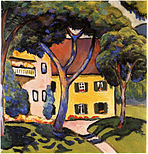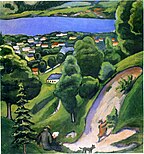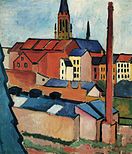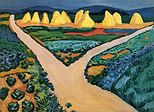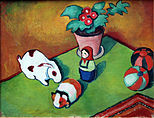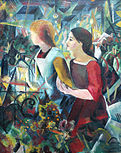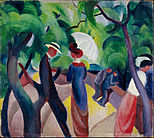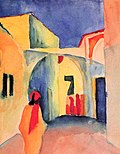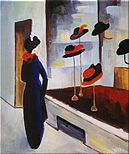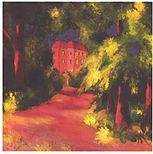August Macke
You can help expand this article with text translated from the corresponding article in German. (September 2021) Click [show] for important translation instructions.
|
This article needs additional citations for verification. (July 2015) |
August Macke | |
|---|---|
 August Macke, Self-portrait, 1906, oil on canvas | |
| Born | 3 January 1887 Meschede, German Empire |
| Died | 26 September 1914 (aged 27) near Perthes-lès-Hurlus, Champagne, France |
| Resting place | German Military Cemetery, Souain-Perthes-lès-Hurlus |
| Nationality | German |
| Known for | Painting |
| Notable work | List of paintings |
| Movement | Expressionism |
| Signature | |
 | |
August Robert Ludwig Macke (3 January 1887 – 26 September 1914) was a German Expressionist painter. He was one of the leading members of the German Expressionist group Der Blaue Reiter (The Blue Rider). He lived during a particularly active time for German art: he saw the development of the main German Expressionist movements as well as the arrival of the successive avant-garde movements which were forming in the rest of Europe. As an artist of his time, Macke knew how to integrate into his painting the elements of the avant-garde which most interested him.[1] Like his friend Franz Marc and Otto Soltau, he was one of the young German artists who died in the First World War.
Early life
[edit]
August Robert Ludwig Macke was born in Germany on 3 January 1887, in Meschede, Westphalia. He was the only son of August Friedrich Hermann Macke (1845–1904), a building contractor and amateur artist, and his wife, Maria Florentine, née Adolph, (1848–1922), who came from a farming family in Westphalia's Sauerland region. Shortly after August's birth the family settled at Cologne, where Macke was educated at the Kreuzgymnasium (1897–1900) and became a friend of Hans Thuar, who also became an artist. In 1900, when he was thirteen, the family moved to Bonn, where Macke studied at the Realgymnasium and became a friend of Walter Gerhardt and Gerhardt's sister, Elisabeth, whom he married a few years later.
The first artistic works to make an impression on the boy were his father's drawings, the Japanese prints collected by his friend Thuar's father and the works of Arnold Böcklin which he saw on a visit to Basel in 1900. In 1904 Macke's father died, and in that year Macke enrolled at the Kunstakademie Düsseldorf, under Adolf Maennchen (1904–1906). During this period he also took evening classes under Fritz Helmut Ehmke (1905), did some work as a stage and costume designer at the Schauspielhaus Düsseldorf, and visited northern Italy (1905) and Netherlands, Belgium and Britain (1906).
Artistic career 1907–1914
[edit]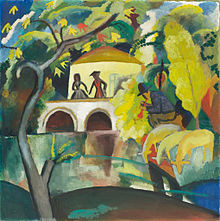

Thereafter Macke lived most of his creative life in Bonn, with the exception of a few periods spent at Lake Thun in Switzerland and various trips to Paris, Italy, the Netherlands and Tunisia. In Paris, where he traveled for the first time in 1907, Macke saw the work of the Impressionists, and shortly after he went to Berlin and spent a few months in Lovis Corinth's studio. His style was formed within the mode of French Impressionism and Post-Impressionism and later went through a Fauve period. In 1909 he married Elisabeth Gerhardt. In 1910, through his friendship with Franz Marc, Macke met Kandinsky and for a while shared the non-objective aesthetic and the mystical and symbolic interests of Der Blaue Reiter.
Macke's meeting with Robert Delaunay in Paris in 1912 was to be a sort of revelation for him. Delaunay's chromatic Cubism, which Apollinaire had called Orphism, influenced Macke's art from that point onwards. His Shops Windows can be considered a personal interpretation of Delaunay's Windows, combined with the simultaneity of images found in Italian Futurism.

The exotic atmosphere of Tunisia, where Macke traveled in April 1914 with Paul Klee and Louis Moilliet was fundamental for the creation of the luminist approach of his final period, during which he produced a series of works now considered masterpieces, like his famous painting Türkisches Café. August Macke's oeuvre can be considered as Expressionism (in its original German flourishing between 1905 and 1925), and also as part of Fauvism. The paintings concentrate primarily on expressing feelings and moods rather than reproducing objective reality, usually distorting colour and form.
Macke's career was cut short by his early death in the second month of the First World War at the front in Champagne, France, on 26 September 1914. He was buried in the German Military Cemetery in Souain-Perthes-lès-Hurlus.[2] His final painting, Farewell, depicts the mood of gloom that settled after the outbreak of war.
Selected paintings
[edit]-
The artist's wife in blue hat, 1909
-
Staudacher's house at the Tegernsee, 1910
-
Tegernsee landscape, 1910, Germanisches Nationalmuseum
-
Landschaft am Tegernsee mit lesendem Mann, 1910
-
St. Mary's with houses and chimney (Bonn), 1911, Kunstmuseum Bonn
-
Vegetable fields, 1911, Museum Ludwig, Cologne, Germany
-
Little Walter's Toys, 1912, Städel
-
Two girls, 1913, Städelsches Kunstinstitut
-
Leute am blauen See, 1913
-
Promenade, 1913
-
Lady in a Green Jacket, 1913, Museum Ludwig, Cologne, Germany
-
View into a lane, 1914, watercolor
-
Kairouan (III), 1914, watercolor, Westphalian State Museum for Art and Cultural History, Münster
-
Hutladen III, 1914
-
Red house in the park, 1914
-
Portrait of Bernhard Koehler, 1910, Städtische Galerie im Lenbachhaus, Munich
-
Turkish Café, 1914, Städtische Galerie im Lenbachhaus, Munich
-
Indians on Horseback, 1911, Städtische Galerie im Lenbachhaus, Munich
August Macke Prize
[edit]The August Macke Prize, was given the first time in 1959 by the districts Arnsberg, Brilon, Olpe and Meschede, town of birth of August Macke in Germany.
August-Macke-Haus
[edit]The August-Macke-Haus is a museum dedicated to August Macke founded in 1991. It is located in Macke's former home in Bonn, where he lived from 1911 to 1914.
Art market
[edit]At a 1997 Christie's auction, Macke's The Couple at a Garden Table (1914) was sold for £2 million.[3] Market in Tunis (1914) sold for £2.86 million ($4.1 million) in 2000.[4] Consigned by the estate of Ernst Beyeler, the artist's In the Bazar (1914) was auctioned for £3.96 million – then four and a half times the high estimate – at Christie's in 2011.[5]
In 2007, the Berlin auction house Villa Grisebach sold Macke’s Woman with a Parrot in a Landscape for €2.4 million, setting a record price for the artist. The painting's provenance mentioned it was confiscated in 1937 as 'degenerate'. In the 2008 catalogue of Macke’s works, Hildebrand Gurlitt, Hitler's art dealer was mentioned in the provenance.[6]
References
[edit]- ^ "August Macke – The Complete Works – Biography". augustmacke.org. Retrieved 22 June 2019.[circular reference]
- ^ "Biography". August Macke Haus. Archived from the original on 1 August 2007.
- ^ Melikian, Souren (25 October 1997). "Great Substitution Game Generates High Stakes and Huge Profits". The New York Times. International Herald Tribune. Retrieved 22 June 2019.
- ^ Melikian, Souren (28 October 2000). "Brokerages May Alter the Art Game : Earthquakes in the Auction World". The New York Times. Retrieved 22 June 2019.
- ^ Melikian, Souren (23 June 2011). "Christie's Sale Soars, Driven by Beyeler Estate". The New York Times. Retrieved 22 June 2019.
- ^ Schmidt, Thomas E. (30 November 2013). "Münchner Kunstfund: August Macke aus Gurlitt-Nachlass bei Grisebach versteigert". Die Zeit (in German). ISSN 0044-2070. Retrieved 24 November 2024.
Further reading
[edit]- Cohen, Walter (2013). August Macke. New York: Parkstone International. ISBN 9781783101566. OCLC 855505275.
- Heiderich, Ursula (1997). August Macke Aquarelle : Werkverzeichnis [August Macke Watercolor : catalog raisonné] (in German). Ostfildern-Ruit: Hatje. ISBN 9783775707039. OCLC 38269020.
- Heiderich, Ursula; Franz, Erich (2001). August Macke und die frühe Moderne in Europa [August Macke and early modernism in Europe] (in German). Ostfildern-Ruit: Hatje Cantz. ISBN 9783775711463. OCLC 473387539. (exhibition catalogue)
- Meseure, Anna (2000) [1991]. August Macke, 1887-1914. Translated by Galbraith, Iain. Koln & New York: Taschen. ISBN 9783822858592. OCLC 224848547. OCLC 49359514, 438429433.
- Moeller, Magdalena M; Dahlmanns, Janina (2002). August Macke und die Rheinischen Expressionisten : Werke aus dem Kunstmuseum Bonn und anderen Sammlungen : Brücke-Museum Berlin, 28. September 2002 bis 5. Januar 2003 : Kunsthalle Tübingen, 18. Januar bis 6. April 2003 [August Macke and the Rhenish Expressionists: Works from the Kunstmuseum Bonn and other collections: Brücke-Museum Berlin, September 28, 2002 to January 5, 2003: Kunsthalle Tübingen, January 18 to April 6, 2003] (in German). München: Hirmer. ISBN 9783777495408. OCLC 51061551, 558197343. (exhibition catalogue)
- Vriesen, Gustav (1957) [1953]. August Macke (in German) (2nd ed.). Stuttgart: W. Kohlhammer. OCLC 930409382.
External links
[edit]- Robert Delaunay, letter to August Macke, 1912 Archived 7 May 2007 at the Wayback Machine
- Biography with photos at August Macke Haus web site
- Works by or about August Macke at the Internet Archive
- Works by August Macke at LibriVox (public domain audiobooks)

- August Macke
- 1887 births
- 1914 deaths
- 20th-century German painters
- 20th-century German male artists
- German Expressionist painters
- German male painters
- German military personnel killed in World War I
- German Orientalist painters
- People from Meschede
- People from the Province of Westphalia
- German Army personnel of World War I


